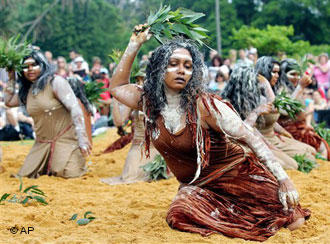EU museums face calls to return human remains
[caption id="attachment_1325" align="alignright" width="330" caption="Australia has actively sought to recover remains for its Aboriginal communities. Image: www.dw-world.de"] [/caption]
Austria's Ethnology Museum is one of many European institutions thinking about the skeletons in its closets as calls for restitution have increased from displeased groups.
'The bones are alive'
The Australian government actively supports the return of Aboriginal remains. Around a thousand samples have been returned since 1990, but hundreds remain in museums, mostly in Europe and the United States.
Austrian institutions recently returned 30 specimens to their traditional owners. Reverend Lenore Parker from Australia is an advocate of restitution and was on hand to collect some of the remains Austria returned.
[/caption]
Austria's Ethnology Museum is one of many European institutions thinking about the skeletons in its closets as calls for restitution have increased from displeased groups.
'The bones are alive'
The Australian government actively supports the return of Aboriginal remains. Around a thousand samples have been returned since 1990, but hundreds remain in museums, mostly in Europe and the United States.
Austrian institutions recently returned 30 specimens to their traditional owners. Reverend Lenore Parker from Australia is an advocate of restitution and was on hand to collect some of the remains Austria returned.
 [/caption]
Austria's Ethnology Museum is one of many European institutions thinking about the skeletons in its closets as calls for restitution have increased from displeased groups.
'The bones are alive'
The Australian government actively supports the return of Aboriginal remains. Around a thousand samples have been returned since 1990, but hundreds remain in museums, mostly in Europe and the United States.
Austrian institutions recently returned 30 specimens to their traditional owners. Reverend Lenore Parker from Australia is an advocate of restitution and was on hand to collect some of the remains Austria returned.
[/caption]
Austria's Ethnology Museum is one of many European institutions thinking about the skeletons in its closets as calls for restitution have increased from displeased groups.
'The bones are alive'
The Australian government actively supports the return of Aboriginal remains. Around a thousand samples have been returned since 1990, but hundreds remain in museums, mostly in Europe and the United States.
Austrian institutions recently returned 30 specimens to their traditional owners. Reverend Lenore Parker from Australia is an advocate of restitution and was on hand to collect some of the remains Austria returned.
"These are not remains; they are far more than that. For us, the bones are alive, and they are still very much a part of our community," Parker explained, adding, "We still have that sense of belonging, and this is still one of our valued ancestors."In search of a new approach The returns of the past few years could be just the tip of a very big iceberg. Many institutions prefer not to face the issue, afraid that once they reveal what's in their archives, they could lose their collections and see a decline in visitors. But museums' fears are often beside the point, argues Katarina Matiasek of the Museum for Ethnology in Vienna. "I would say today our exploration no longer goes into far away countries but into the archives and vaults of the institutions themselves to re-evaluate what has been done. And these collections say more about the collectors than the collected people themselves," Matiasek said. In this new climate, friction is inevitable between museums and the populations whose ancestors are included in their collections. Consulting with people from the cultures involved can be mutually beneficial, said Christian Schicklgruber, the Museum of Ethnology's deputy director. "The traditional way of ethnographic exhibition is simply boring both to audiences and curators - that's in contrast to 100 years ago, where no one had seen such objects before," explained Schicklgruber. "So the trend goes toward inviting the people whose ancestors are exhibited to get into a dialogue and find new ways to present the objects we have." 'Leaving out half of the story' Despite the sensitivity involved in displaying human remains, the Vienna museum is planning an exhibition showing human skulls from the Naga region of India, which were preserved as trophies of slain enemies. "They exhibited the heads on a tree in the very center of the village, and in 1936 an Austrian anthropologist got five of these heads and brought them back to the museum, where they have not been seen by anybody since," Schicklgruber said, noting that he fully expects his decision to display the skulls will draw criticism. The curator has visited and consulted with the Naga tribes, who told him they neither want the heads back nor object to them being exhibited. Schicklgruber believes that legitimizes exhibiting the skulls. "Head-hunting is one of the most interesting topics, so not to show the main object - the heads - would be leaving out half of the story," argued the museum director. An exhibition on the Naga people is planned for next spring. Author: Kerry Skyring / gsw Editor: Kate Bowen [Source] Deutsche Welle: European museums face calls for restitution of ancestral remains
Related Content
French museum returns a Māori head to New ZealandSimilar content
from - to
01 Feb 2012 - 11 Jun 2012
21 Jun 2015 - 23 Jun 2015
posted on
26 Feb 2012
22 Sep 2017 - 21 Jan 2018
25 May 2017 - 30 Mar 2018
